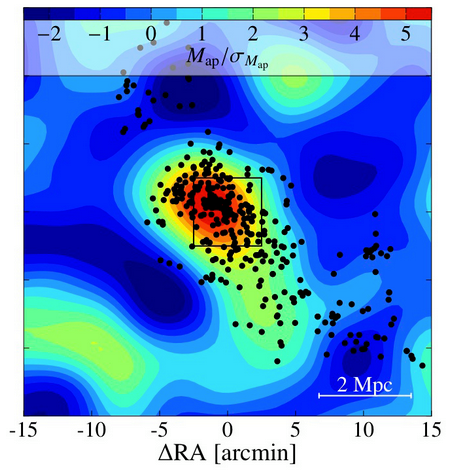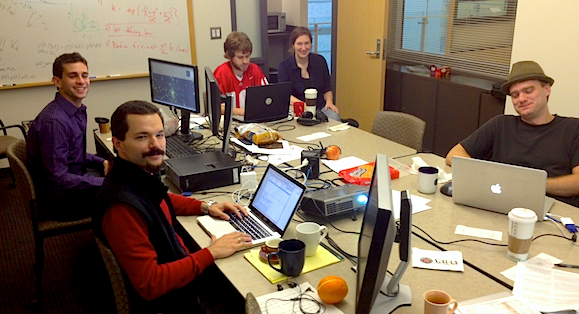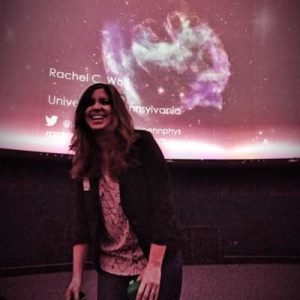This paper summarizes studies of the mass and galaxy distribution in and around four massive galaxy clusters. It is the first paper that made use of data from the Dark Energy Survey, taken during an initial testing phase called Science Verification that lasted from September 2012 to February 2013. Not only does this paper present new research into clusters, but it provides important early tests of data delivered by the Dark Energy Camera (DECam) and data analysis methods used by the Dark Energy Survey.
Galaxy clusters—accumulations of hundreds of galaxies—are said to be the largest gravitationally bound structures in the universe. While this statement is conceptually correct, it might suggest that clusters are static, isolated systems. Nothing could be further from reality. Galaxy clusters are not isolated and they actively accrete material from their surroundings. The preferred mode of accretion proceeds along so-called filaments, the connecting links between clusters, the fabric of the cosmic web. The existence of filaments is a prediction of the cold dark matter model we use to describe the formation of structures in the universe.
The authors of this paper (more than 90 people from 37 different institutions) performed a careful analysis of the distributions of galaxies in the clusters. These “red-sequence” galaxies don’t look like the Milky Way: they don’t have spiral arms or clumps of bright blue stars, but have a smooth distribution of faint red stars. The scientists also determined the distribution of dark matter in the clusters using an effect called gravitational lensing. This required exceptionally good images of galaxies that are in the same direction as the cluster, but much further away. One also needs to examine many of these distant galaxies: about half a million of them were analysed for each of the four clusters.

This plot shows the mass distribution from weak-lensing measurements (contours) and red-sequence galaxies (black dots) of the galaxy cluster RXC J2248.7-4431 at redshift z=0.348. It is evident that galaxies and mass distribution are in good agreement over distances of several million light years (2 Mpc, or 2 Megaparsecs, is roughly 7 million light years). This was an anticipated result and welcome validation of the potential for gravitational lensing analysis with the Dark Energy Survey. The red-sequence galaxy distribution extends substantially farther out (about 15 Mpc), reaching a total length of approximately 1 degree, or twice the diameter of the full moon.
The authors were delighted when everything lined up as expected: from the brightest cluster galaxies sitting at the cluster centers, to the mass distribution tracing hundreds of cluster galaxies, to the distribution of red-sequence galaxies far from the center. All these probes show that clusters are indeed interwoven with the cosmic web. This is just the start. Over the next few years, DES will reveal the cosmic web across a wide swath of the Southern Sky in unprecedented detail.
About the Paper Authors
 This work was a large team effort, spearheaded by Peter Melchior, Eric Suchyta, and Eric Huff from the Center for Cosmology and Astroparticle Physics (CCAPP) of Ohio State University. The preferred mode of operations is shown in the image below. Dubbed “busy week”, we joined forces in one room, creating an intense and productive environment for post-docs and graduate students alike. Not to mention: It’s fun!
This work was a large team effort, spearheaded by Peter Melchior, Eric Suchyta, and Eric Huff from the Center for Cosmology and Astroparticle Physics (CCAPP) of Ohio State University. The preferred mode of operations is shown in the image below. Dubbed “busy week”, we joined forces in one room, creating an intense and productive environment for post-docs and graduate students alike. Not to mention: It’s fun!
About The DArchive Authors & Editors

Rachel C. Wolf is an astrophysics PhD candidate at the University of Pennsylvania. She is primarily interested in how to best use Type Ia supernovae to understand more about the evolution of our universe. Most of her work has focused on studying correlations between supernova brightness and host-galaxy properties and on creating new statistical techniques to compare observational data to cosmology theory. Rachel is also very passionate about science education and public outreach. She is involved in many projects in the Philadelphia community and serves as one of the co-coordinators of Education & Public Outreach for DES.